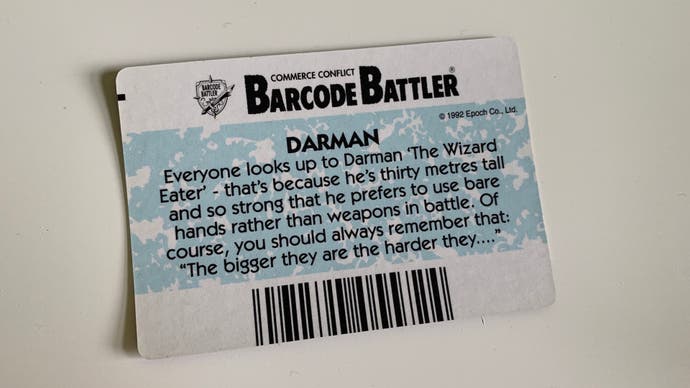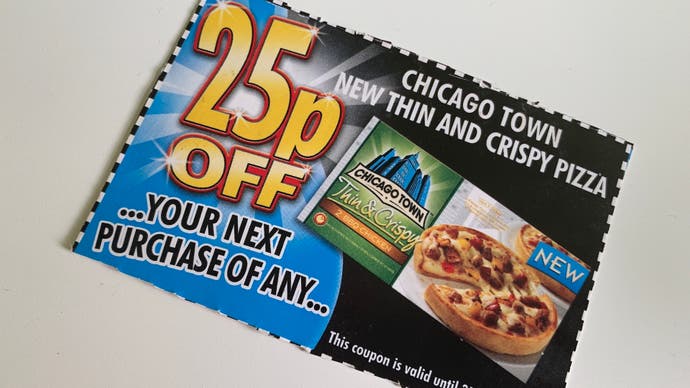Not even Mario and Zelda could make the Barcode Battler any good
But it did do its part to shape the modern gaming world.
Years ago, when I worked in retail in a long gone Blockbuster store, Easter was an awkward time of year. Not because seemingly everyone on the face of the Earth wanted a copy of Slumdog Millionaire or Taken and didn't understand the concept of limited stock, but because of Creme Eggs. I'm no fan of Creme Eggs, admittedly. They're cloyingly sweet. But it was the packaging that was the real problem. Their small yet vital barcode was wrapped around the egg-shaped chocolate and that made it impossible to scan easily. In time, I ended up memorising the barcode number (known as an EAN) while still cursing quietly about the Creme Egg design.
And yet, I was the one who so desperately wanted a Barcode Battler when I was about 7. But, hey, kids rarely know what's best for them, right?
The Barcode Battler took the concept of the humble barcode and turned it into an 'amazing' game of exciting combat and thrills and spills. I say 'amazing' because that's how the instruction manual describes it. It's wrong. Very wrong.

The barcode was invented back in the 1950s to automate supermarket checkout systems and they're incredibly useful. Combined with the EAN, they speed up scanning items in a way that, presumably, people could only dream of beforehand. They're immensely handy little things yet as tedious as anything made up of a bunch of black stripes could be. Except for Zebras, of course. Somehow, in 1991, Epoch decided to turn the barcode into a gaming phenomenon. Well, a short-lived gaming phenomenon in the UK.
Better known for manufacturing my favourite childhood toy, Sylvanian Families, Epoch had been around for much of the 20th Century. It developed many LCD handheld games at a time when these were genuinely exciting rather than gimmicky. It was also responsible for Doraemon, a Japanese manga series that you'd be forgiven for not being massively acquainted with. But it's the Barcode Battler that's the company's most fascinating invention.
The concept was much like Top Trumps. Only with barcodes. Each Barcode Battler came with a set of cards that had barcodes attached to them. The point was to create a powerful character through a strong combination of barcode swiping and hoping for the best, because stats were randomly assigned through an algorithm. Not all of these cards were player characters. Instead, you'd have cards that represented enemies or power-ups such as extra strength or weaponry.
Crucially, you weren't limited to these game cards. Instead, you could use barcodes from everyday life. Walking around a supermarket and intrigued how much game strength can come from a packet of toilet roll? Now you can find out! Assuming you detach the barcode from the product and swipe it through the narrow portal of the Barcode Battler, that is.

Still, back then, that kind of thing sounded ridiculously exciting to some. In 1991, the first Barcode Battler was released in Japan and it was a huge success. That original Barcode Battler was identical in shape to the one we saw in Europe, albeit with a white case. Battles were simpler too, which was almost certainly a blessing.
In Japan, the Barcode Battler proved to be so popular that special edition cards were created. Rather than being stuck with characters like Jam Bam or Dolcoon, you could import characters from Super Mario or The Legend of Zelda. These had their own unique stats and power and all the strength that comes from Nintendo licensing. And, of course, there were special cards for the Doraemon series because that just makes perfect sense.
The Zelda series of cards in particular were fascinating. Based on A Link to the Past, they enabled players to compete in themed battles as either Warrior or Wizard with the eventual plan being that you had to swipe the Ganon card to face off against everyone's favourite nasty piece of work before 'winning' the game. There was a kind of plot, but the thing about the Barcode Battler is it didn't really have the intelligence to make a plot work. Instead of relying on the console to tell you the story, you had to read the accompanying manuals and cards to learn more.
You see, the back of each card has a little intro to the character. They're woefully cheesy at times. Who cares if Darman, the curiously horned beast, is looked up to by everyone because he's so tall. Or that Razor Fist has a great sense of humour? They almost seem more like the kind of cheesy one liners you'd see on a Tinder profile than in a game.

The Barcode Battler didn't do so well in the West.
The Barcode Battler in the West was technically the Barcode Battler II. It featured an extended single player mode, some other tweaks, and an output port that offered interface capabilities which proved to be rather interesting and something worth talking about later.
I vaguely remember its release because I was a strange 7-8-year-old who was tech-obsessed even then. I saw the Battler in stores lined up next to the Game Boy and the Game Gear and you can see the problem right there, can't you? I wasn't a savvy kid so I desperately wanted a Barcode Battler. Anything that could make a shopping trip more exciting sounded good to me. I should be eternally grateful that my parents bought me a Game Boy instead of Epoch's not-so-mighty gimmick.
Skim past nearly 30 years, and here I am - 34 years old and with a Barcode Battler in my possession. And boy, was I excited when it showed up. And guess what? It's utterly rubbish. I'm fairly confident I'd have felt the same back then too, since Game Boys and Game Gears are still pretty fun, and even the ropey Sonic LCD handheld game I used to own has its moments. This though? This is rubbish.
It looks impressive. I bought a boxed Barcode Battler off eBay and it arrived in fantastic condition. The manuals are untouched, the card sets are in great condition, and the device itself looks chunky and distinctly 90s-ish. It also came with a handful of barcodes from other products, presumably cut out by the previous owner. Weirdly, there's a coupon for 25p off a Chicago Town Pizza and it ran out in 2007 so I'm guessing I'm not the only one to pursue the nostalgia route.

Bung some batteries in and the Barcode Battler gleefully pings at you. The process of getting started is more confusing than you'd think, with a choice of settings vaguely described as C-0 and C-1. Fortunately, the manual is excited to tell you all and uses enthusiastic words like 'amazing' while it goes along too. Essentially, there's a choice of a single-player mode or a two-player mode. The idea is similar regardless, though - swipe barcodes to build up the strength of your character so they're better than the other person.
I swiped my first barcode and immediately had a flashback to the Blockbuster days. Oh no.
The barcode scanner is temperamental to the extreme. You have to swipe just fast enough. But also not so slow that it doesn't read the black lines correctly. It's a game in itself but one that you soon tire of when you hear the machine bleep sadly and briefly display a 'miss' on its ancient-looking LCD screen.
Once you eventually succeed with scanning anything, you have to work your way through a myriad of menus with vague descriptions that ultimately drive you towards the manual to figure out just what is going on. Game design has come a long way in recent years but really, it was generally better than this back then too.
Imagine a poor child trying to do this when they could have been enjoying Super Mario Land or Sonic the Hedgehog instead. And so my 25-year love affair with the idea of the Barcode Battler was erased. Kind of like if you met a beloved celebrity and they spat in your face because you dared to say 'hi'.
And yet, I can see the potential. You see, the Barcode Battler was actually fairly important in a weird sort of way. Remember that output port? It's something that Nintendo took advantage of, allowing it to be attached to the Famicom and Super Famicom in Japan in a similar way to how the Game Boy Player works with the GameCube and e-Reader. Obviously, that all requires extra technology (i.e. the superior games console) but it meant some exciting times in Japan.
Games like Barcode World meant a more extended version of the Barcode Battler way of doing things, and actually made things more interesting. Best of all was when licensed games like The Amazing Spider-Man: Lethal Foes meant that extra content could be unlocked by scanning barcodes. You're collecting new things as you go along. And doesn't that sound familiar?
On the one hand, that's like scanning QR codes for mostly everything on the face of the planet right now. It's very Pokémon-esque given you also have that hefty bunch of Barcode Battler cards to collect and potentially trade or discuss with your mates. There are even elements of Skylanders here, as the Barcode Battler has a scanner that works kind of like a portal.
And maybe that's the Barcode Battler's greatest legacy. It wasn't very good at all and deserved to be wiped out by the Game Boy and Game Gear, but what if it made people think just a little differently? Think outside the box and realise that collecting cards is fun, scanning things offers ownership, and there's a different way of doing things. Maybe it's worth the sacrifice made by those poor children who received one of these monstrosities instead of a Game Boy.
I'm just glad I didn't find out until now. Anyone want to buy a Barcode Battler?

